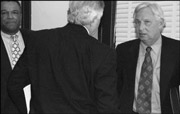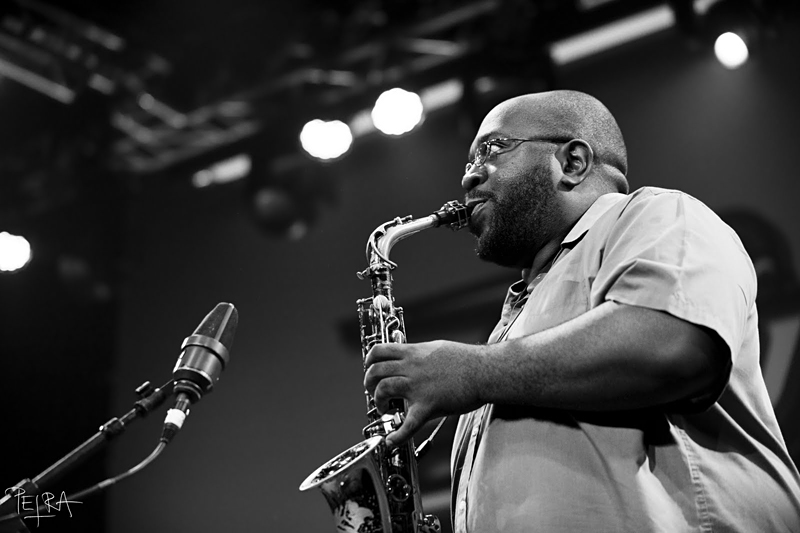So this is what it takes to stop Sound Transit . . . some congressman from Kentucky?
It may be. Last week, the incoming chair of the House appropriations transportation subcommittee, a Republican named Hal Rogers, threw a wrench into Sound Transit’s $3.8 billion light-rail venture, calling for a thorough review of the project before the feds help pay for it. Just days after his comments, Sound Transit’s executive director, Bob White, resigned.
Rogers’ demand echoes that of light-rail critics here at home, who’ve repeatedly called—in vain—for an audit of the electric-train project.
For the moment, it’s unclear whether Rogers’ concerns will put the brakes on light rail or be just another in the long series of yellow lights. But it is ironic that this DC power broker may be in a position to do what no activist, politician, or geologic obstacle around here has been able to do: Shut this thing down.
Since voters first approved a tax hike to create Sound Transit back in November 1996, the agency has been like the Black Knight in Monty Python and the Holy Grail, rebounding from every apparent death blow to its credibility: You slice off his arm, he calls it a flesh wound; hack away two more limbs, he calls you a coward and asks if that’s all you can manage; even when nothing’s left but a helpless head on a torso, he’s still taunting you and ready to fight on. The Monty Python character is just amusingly deluded. Sound Transit fights on with no limbs and, shockingly enough, wins.
Earlier this month, the Sound Transit board voted, yet again, to push ahead with light rail, overcoming what seemed like a fatal phalanx of flaws, doubts, overruns, and opponents. No matter that the project is a billion dollars over its budget and three years off its promised schedule. No matter that it is not expected to provide relief from traffic congestion. No matter that some of the most powerful civic groups in the city have lost faith in the plan. No matter that the agency has been so badly managed that its two top executives, White and light-rail director Paul Bay, were forced out before construction has even started.
The train trundles on. But why? What is the unstoppable force?
Conversations with a number of canny local observers—some on the record, some off—led to 10 reasons light rail has kept right on running.
1. Blind lust for federal bucks
From the start, one of the selling points of light rail was that the federal government would help pay for it. This quest for federal cash became an end in itself—and has provided a useful tool for snuffing out dissent. Repeatedly, those who sought to raise questions about light rail were warned that if we wanted to score the so-called Full Funding Grant Agreement with the feds, we had to present a happy face of “consensus.” And no one wanted to be responsible for the region’s losing out on hundreds of millions in free money.
So, for example, when King County Executive Ron Sims and Seattle Mayor Paul Schell began airing serious doubts about light rail and openly looking for alternatives during the summer of 1999, they were heavily pressured to fall back into line—by both fellow Sound Transit board members and Senators Gorton and Murray, who wrote a letter warning that if local officials didn’t get in step, we could lose our turn at the Treasury trough.
Similarly, when the University of Washington, swallowing hard, signed an agreement last spring allowing Sound Transit to build a station on UW property—despite deep misgivings about the impact on the University neighborhood and about sending passengers down 200 feet by elevator to the train platform—University regent Shelly Yapp explained, “We became convinced that [Sound Transit] would be out of the ball game for funding” if the U didn’t relent.
Even the many board members and other civic observers concerned about the risks and budget problems must confront one truth about light rail: Without checks from the feds, we’ll be even more screwed. Last Friday, on the final day of the Clinton Administration, outgoing federal regulators signed the Full Funding Agreement, under which the feds more or less pledge to put up $500 million for the first leg of light rail. That’s only a third of what Sound Transit will need. Sound Transit has been steadily increasing the amount of federal money that it’s counting on to fund the project— an act of faith that’s looking dicier than ever after last week’s comments from the Kentucky Republican.
2. Everyone’s feeding off it
Sound Transit is strapped for cash only by the colossal standards of what it’s trying to build. In fact, it already has boxcars of money coming in from local taxpayers. It collected about a quarter of a billion dollars in sales tax and license tab revenue last year alone, and it’s got many times that amount available by issuing bonds against future collections. That kind of wealth gives Sound Transit a huge amount of regional power. And since the agency has been spreading the largesse around, lots of people have a tremendous incentive to “move forward.”
Sound Transit has already put some 52 Puget Sound law firms “on retainer,” making it difficult for light-rail opponents to get legal representation. Likewise every engineering firm, environmental consultant, construction company, subcontractor, community outreach coordinator, real-estate acquisition specialist, labor union, architect, excavator, and diversity trainer in town can expect to get their piece of the action—not to mention the millions of dollars in fees for bond attorneys and lifelong employment for the huge Sound Transit staff.
Regionally, Sound Transit has also been showing its muscle. “Over the last year and a half, they have come out and bought themselves a seat at the table in every major transportation project in East King County,” says Bruce Nurse, a longtime transit detractor and the vice president for government affairs at Kemper Development, which runs Bellevue Square. “[The city of] Bellevue doesn’t want to criticize them because they don’t want the money to go away.” Sound Transit’s stature has been further enhanced since the state Department of Transportation’s budget was stripped by a third, thanks to Initiative 695. Eyman’s tax-cutting initiative left Sound Transit unscathed.
3. It’s so complex that not even the board can understand it
The members of Sound Transit’s board of directors are busy. They have other full-time jobs as mayors, county executives, and city and county council members, dealing with the concerns of people who voted them into office. They do not have time to dig into the details of a staggeringly complex and expensive piece of engineering, with all its attendant financial minutiae.
They can’t be expected to judge whether it’s better or worse to “reduce the length and size of the crosspassages between the twin-tube tunnels” under the Lake Washington Ship Canal, or to understand how this might affect train operations and subsurface easements, or to know whether or not it’s a good idea to defer construction of a “combined traction power substation (TBSS), emergency fan facility, and vent shaft in the SR 520 right of way” and to understand how this change might affect station design and function. Yet board members are being asked to issue decisions on these very subjects. (The above come from a list of possible cost-saving measures recently presented to the board by Sound Transit.)
Once, while in the middle of a highly involved discussion of “grant anticipation notes,” a top financial executive with Sound Transit said to this reporter, “You understand this better than some of our board members. I hope they read your story.”
4. The people who run it aren’t accountable
Because of the above-mentioned difficulty, Sound Transit board members are entirely at the mercy of the Sound Transit staff—engineers, consultants, and number crunchers who understand the fine points and who are not elected. These people have essentially one goal: to build light rail.
Unfortunately, these staffers (at least those in executive positions) have also proven to be—in the kindest term—unreliable. Up until last month, they were assuring the board and the public that light rail was “on time and on budget,” when in fact it was nowhere near either.
Even after all the revelations in December and all the mea culpas from Sound Transit executives, it took board member Rob McKenna to point out this month that Sound Transit was still fudging its numbers and had understated even the new light-rail price tag by several hundred million.
5. Wall Street’s in the clear
When you’ve got investors, they can keep you honest. But in this case, the big institutional investors who will buy up Sound Transit bonds don’t provide any accountability either. To them it won’t make a damn bit of difference if the tunnel-boring machines come out on the wrong side of Capitol Hill or if the Beacon Hill shell implodes—they get paid off either way. That’s because Sound Transit bonds are backed by our local sales taxes, which Sound Transit gets to collect as long as it needs to; nothing’s tied to light-rail revenues at all. The situation contrasts with WPPSS, the notorious early ’80s fiasco in which a massive default occurred after several proposed Washington state nuclear power plants went over budget and couldn’t cover their payments.
6. Boonies on the board are eager for light rail
Only five of the 18 politicians on Sound Transit’s board of directors are actually from Seattle, where light rail is to be built. The rest of them are from East King County and other points north and south. None of these board members will see their neighborhoods disrupted by light rail, nor are they obliged to pay for it; by the financial policies of Sound Transit, only tax money from North and South King County can be used for the project. Politicians from places like Federal Way and Everett know their areas could use the jolt of economic development that a multi-billion-dollar transit project provides. They and others want to see the current light-rail plan up and running as soon as possible so it can then be extended beyond Seattle borders.
“The people on the west side of the lake have their own issues,” Connie Marshall, Bellevue’s deputy mayor, recently told the Eastside Journal. “The Eastside communities want to begin planning phase II to begin solving Eastside congestion.”
7. Politicians are busy fighting each other
Since light rail is being built and paid for in King County, any significant movement for change would have to come from the King County board members. But within that contingent are strong political rivalries, which may have rendered any unified reform bloc impossible.
Mayor Schell has maintained a skeptical but essentially noncommittal air on light rail since the beginning of his administration (though that didn’t stop him from voting to sign the federal grant agreement this month). Even while he and Ron Sims were actively seeking a way out of the project, they never combined their efforts. Their lack of a close alliance has led to bitter turf wars in the past over issues such as water.
Sims has been more of a leader when it comes to taking strong, independent stands, but it’s hardly surprising that he doesn’t want to be the lone man confronting the light-rail train. He tried once before to save us from a big-money community boondoggle, urging a closer examination of the proposed new baseball stadium at a time when the team was pressuring the county to issue bonds immediately. Sims got his head handed to him by the local media and other team boosters, and had to retreat. (Of course, he turned out to be right.)
Nor have Sims or Schell ever made common cause with Republican County Council member Rob McKenna from Bellevue, who has been opposed to light rail from the beginning (and was the only board member to vote against the federal grant). McKenna is considered likely to challenge Sims for his county executive seat this year, and it may well be in anticipation of that fight that Sims, unlike Schell, has now transformed himself into a resolute light-rail booster.
Assuming Schell seeks reelection this year, his opponents will include fellow board member Greg Nickels, a King County Council member who has more or less tied his career to light rail. Nickels sponsored a countywide ballot measure calling for rail back in the late ’80s, and he has been a strong supporter of Sound Transit’s project ever since. Now that the budget has exploded in his face, Nickels is adopting a more cautious tone and calling for an examination of “alternatives.” Even if he is serious, there’s little chance he and Schell will be able to form any kind of coalition.
8. The media and activists were asleep at the switch
Sound Transit went unquestioned for years. Many Sound Transit board members didn’t even bother to show up for the board meetings; Ron Sims attended fewer than half of those held during 1998 and ’99.
Right-thinking Seattleites ignored the early objections of people like McKenna, writing them off as slaves to the car-happy suburbs. Up until very recently, the daily editorial pages came down hard on anyone who dared slow the forward progress of light rail. “Now is the time for [the UW] to move beyond impasse,” intoned The Seattle Times, for example, during last spring’s negotiations.
Only in the last several months has an active opposition force, called Sane Transit, mobilized—one that speaks for more than the objections of specific neighborhoods (Tukwila, Rainier Valley, downtown) and includes more than just the people who have opposed light rail all along.
9. Hopelessly devoted to rail
There is no doubt that most of the officials on the Sound Transit board believe that rail is the right thing to do—both politically and for the region’s transportation future. We voted for it four years ago, and Sims, for one, thinks that support remains strong: “In all the polls, voters are saying, ‘Build it,'” he says. “At a certain point, we have to start acting.”
Whether voter support is realistic is another question. Bruce Nurse of Kemper Development says he’s been privy to some recent focus groups that indicate “the public is amazingly unaware of what Sound Transit is doing. People are unaware of where it goes and what it actually delivers.”
Nurse believes that, nonetheless, “a large group of the public seems to want rail regardless of price.” Emory Bundy of Sane Transit agrees: “The good-government/ environmental people have this romantic view of rail that won’t stand up to scrutiny,” he contends.
As a result, while light rail may not be the best thing we can do for easing traffic or improving transit, it has become the thing we can do, politically speaking. Sure, free buses and congestion pricing sound good, but will people be willing to tax themselves to pay for it? Mike Vaska of the Greater Seattle Chamber of Commerce is doubtful. “If you’re not going to do this,” he says, “tell me what we can do that voters will support?”
10. Damn the naysayers
Whether it’s the baseball stadium, the third runway, or the Tacoma Narrows Bridge, every major public works project seems to be greeted by outraged protest from someone. “There’s a culture of opposition,” observes attorney Vaska, “and elected officials are getting immunized to some of this. They’re willing to tough it out and take the hits.” They have learned, perhaps, that in the end these protests can be safely ignored. Who ever paid a political price for the two new sports stadiums? Though the voices of an indifferent majority have never been heard inside the Sound Transit boardroom, theirs may actually be the loudest voice of all.








